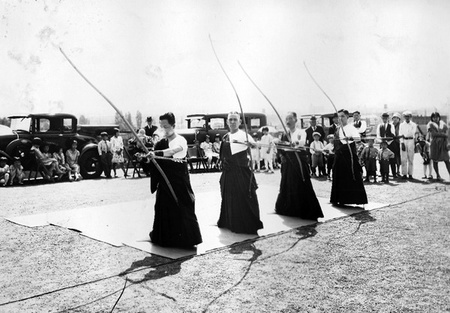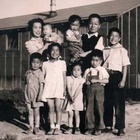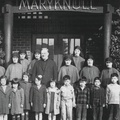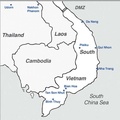What’s this about your papa being a samurai warrior? Your dad was a samurai? Whatever gave you that idea? Do you even know what a samurai is?
Of course I know what a samurai is! I know that just like in England, they were the “knights of olde” who protected the royalty as well as various lesser heads of state, and performed good deeds among the people. In Japan, the samurai were the ones who protected the hierarchy. In the U.S., the closest ones that come to mind are local police.
However, when I was growing up, there was a “learning period” that introduced me to the past societal role of samurai. This is how I learned about that particular Japanese “mibun” or class.
Before World War II, we were living at the Cadillac Hotel in downtown Seattle (today’s Klondike Gold Rush building). As I was growing up there from age four, I became familiar with several objects that related to activities that my father engaged in from time to time.
There was an ultra-long bow — of bow and arrow fame — that I also noted in magazines, books, and various publications. There was a “katana” (sword) that was placed on a special shelf, which was also featured in the same reading materials. Third, there was a round, beautiful black container with a whole lot of sticks with feathers sticking out of the opening, under my parent’s double bed, which I guessed were arrows. Lastly, there was strange, long, black clothing like you see in Japanese media from time to time.
I couldn’t read nor understand the texts in these publications. However, the pictures and photos seemed quite interesting because they related to the things and items in our apartment.
In family conversations, the subject of samurai came up from time to time, primarily between Mama and Papa. Most of the time it arose in their talks relating to old Japan. Mama came to America when she was 12 years old, so most of the discussion consisted of Papa explaining things about samurai to her. It was obvious that Papa was quite knowledgeable about them and seemed to admire them greatly.
In those days, Papa rarely talked to me, except to scold and order me to perform a task, but in an aloof and standoffish manner. Generally, Mama would follow up and explain things when it was obvious that I did not understand.
Although Papa was a well-educated man with a college background, I’m not sure whether he chose or simply maintained the samurai hierarchy of remaining “above it all.” Thank goodness Mama recognized the difficulty I was having attempting to understand the rationale behind what was taking place between Papa and me.
What was thrilling for me was seeing weapons at home identical to samurai ones, like bows and arrows, big and small swords, and the various paraphernalia associated with these weapons. One was the wrist guard used with the bows and arrows; it was obviously used by Papa!
As I became more familiar with the role samurai played in ancient Japan, primarily through conversations with Mama, I started to ask her questions about Papa’s apparently continuing role as a samurai. Primarily, what did he do when he went somewhere with the bow and arrows dressed in that black attire? Mama simply explained that he was going to target practice.
I asked a lot of questions that she couldn’t answer, so she told Papa about my curiosity. I overheard her suggest that he take me along, without a response from him.
Sometime later, Papa finally, though reluctantly, consented to take me to the next target practice. Mama was overjoyed that I was finally going somewhere with him, just the two of us. Looking at Papa, he was obviously not excited about me going along. But, to my eyes, that’s how he always looked, so I could not determine what his feelings and thoughts were about it.
I remained super excited! This was to take place in the spring of 1940, when I was six years old. I continued asking Mama all kinds of questions about an activity which she had never attended. As always, she simply stated that I wait and ask Papa when we went out on the excursion.
The day finally came. While I remember being overly excited about going to bow-and-arrow target practice with Papa, I continued to be unable to read his reaction to this outing. He looked the same as always, stoic, somber, and calm. However, I remember it as the biggest outing of my life until then, with just Papa and me! It was the first time I could remember going somewhere and doing something with him! I planned to ask Papa a lot of questions that only he could answer! How exciting!
From our home in the Cadillac Hotel, at Second and Jackson, we headed straight up Jackson, with me in the front right seat where Mama usually sat. Wow, what an experience!
I needed to know what was going on, so I started to ask questions like I did with Mama. Where were we going? What were we going to do? Was it like going to Alki Beach (since that was one of the common places we went to as a family)? When would we get there?
And his answers? Nothing! He simply faced forward driving and didn’t even look my way. I excitedly asked several more questions and his response was for me to quiet down, essentially, to “shut up.”
I still remember his strong, resounding response in Japanese: “Shaberanai de mite, narainasai!” (Quit talking, watch and learn!)
From Jackson Street, we turned right on 12th Avenue for one block, left on King Street, and drove down the hill past what is now the Nisei Veterans Hall. About halfway between 12th and Rainier Avenue, the next arterial, we turned left onto an unpaved road and parked near several other cars. There, a length of straw matting was placed with round, straw targets about 30 feet away. Here, we got out of the car and Papa gave me strict instructions on how I was to conduct myself.
“Sit in the back with the other onlookers. Don’t wander around!” Just the way he looked at me and the strict, hardened sound of his voice, made me realize that it would not be a playful time for me.
Soon, the person in charge started announcing orders in Japanese that called on the participants to line up on the matting facing the targets. Papa was, fortunately, closest to the right side, where I was, so I could clearly watch him as the formalities progressed.
The participants went through some rituals on the matting. They started initially sitting cross-legged, then moved onto their knees, and finally stood with their bodies turned right. Their heads faced “down range” toward the targets, with their bows in their left hands. The arrows were in their right hands. On command, they all placed their arrows and stretched their bows to shoot. I don’t recall hearing a command, but everyone shot at about the same time.

The sequence of what happened at that point was unclear to me because I was way too busy watching Papa shoot and following his arrows to his target. My recollection was that all of his arrows hit the target, but not in the “bull’s-eye.”
Next, there were a series of commands that had the “samurai” participants loosen their bows and kneel in position. Then on command, all bowed at once. Then the spectators went from where we were to where the participants were, while a bunch of younger men and boys moved over to the target area.
When I went to greet and compliment Papa, he instructed me to go to the target area to help everyone find the arrows that missed the targets and return them to their rightful owners. So, I went to the area behind the targets where the others were wandering around looking for arrows and joined them.
As I was looking, I came across two arrows and brought them back to Papa, who instructed me to take them to their owners, according to a slim color-code on the tips of the arrows. That outing with Papa was quite intriguing, and I was ready to go again; but he only took me once more.
Time passed, World War II started, and Papa’s bow-and-arrow outings came to a stop, for obvious reasons. Virtually all of our belongings were stored in the basement of the Cadillac Hotel, under the auspices of the owner of the café. We were placed in the Minidoka Concentration Camp.
When we returned to Seattle after WWII and were in a position to repossess our belongings, some of our items were gone, one of which was the long bow. However, the arrows and the black quiver were still there. As we moved from the Hunt Hotel to the New Lucky Hotel and places thereafter, the arrows and the quiver were lost as well.
So, the ultimate question that remained is whether Papa was in fact, a samurai. As I grew older, with my curiosity about the legends of the samurai, I found out that the samurai era ended in the middle of the 1800s. Papa was born in 1897.
Mama mentioned, a number of years later, that I changed from a talkative little boy to a quieter, more observant child after that visit. I wonder why.
*This article was originally published in The North American Post on Augusut 15 and September 1, 2023.
© 2023 Shokichi “Shox” Tokita






